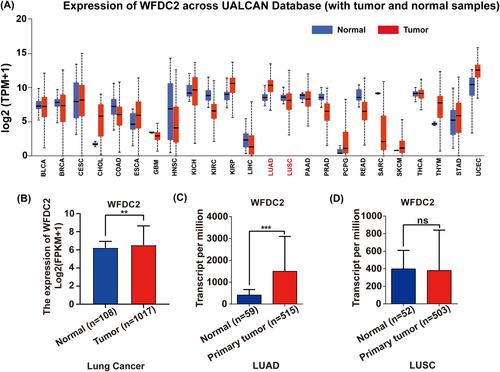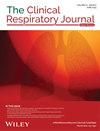Human epididymis protein 4, a novel potential biomarker for diagnostic and prognosis monitoring of lung cancer
Abstract
Objective
This study aimed to explore the application value of human epididymis protein 4 (HE4) in diagnosing and monitoring the prognosis of lung cancer.
Methods
First, TCGA (The Cancer Genome Atlas) databases were used to analyze whey-acidic-protein 4-disulfide bond core domain 2 (WFDC2) gene expression levels in lung cancer tissues. Then, a total of 160 individuals were enrolled, categorized into three groups: the lung cancer group (n = 80), the benign lesions group (n = 40), and the healthy controls group (n = 40). Serum HE4 levels and other biomarkers were quantified using an electro-chemiluminescent immunoassay. Additionally, the expression of HE4 in tissues was analyzed through immunohistochemistry (IHC). In vitro cultures of human airway epithelial (human bronchial epithelial [HBE]) cells and various lung cancer cell lines (SPC/PC9/A594/H520) were utilized to detect HE4 levels via western blot (WB).
Results
Analysis of the TCGA and UALCAN (The University of Alabama at Birmingham Cancer Data Analysis Portal) databases showed that WFDC2 gene expression levels were upregulated in lung cancer tissues (p < 0.01). Compared with the control group and the benign group, HE4 was significantly higher in the serum of patients with lung cancer (p < 0.001). Receiver operating characteristic (ROC) analysis confirmed that HE4 had better diagnostic efficacy than classical markers in the differential diagnosis of lung cancer and benign lesions and had the highest diagnostic value in lung adenocarcinoma (area under the ROC curve [AUC] = 0.826). HE4 increased in early lung cancer and positively correlated with poor prognosis (p < 0.001). Moreover, the results of WB and IHC revealed that the expression of HE4 was increased in lung cancer cells (SPC/A549/H520) and lung cancer tissues but decreased in PC9 cells with a lack of exon EGFR19 (p < 0.05).
Conclusion
Serum HE4 emerges as a promising novel biomarker for the diagnosis and prognosis assessment of lung cancer.


 求助内容:
求助内容: 应助结果提醒方式:
应助结果提醒方式:


